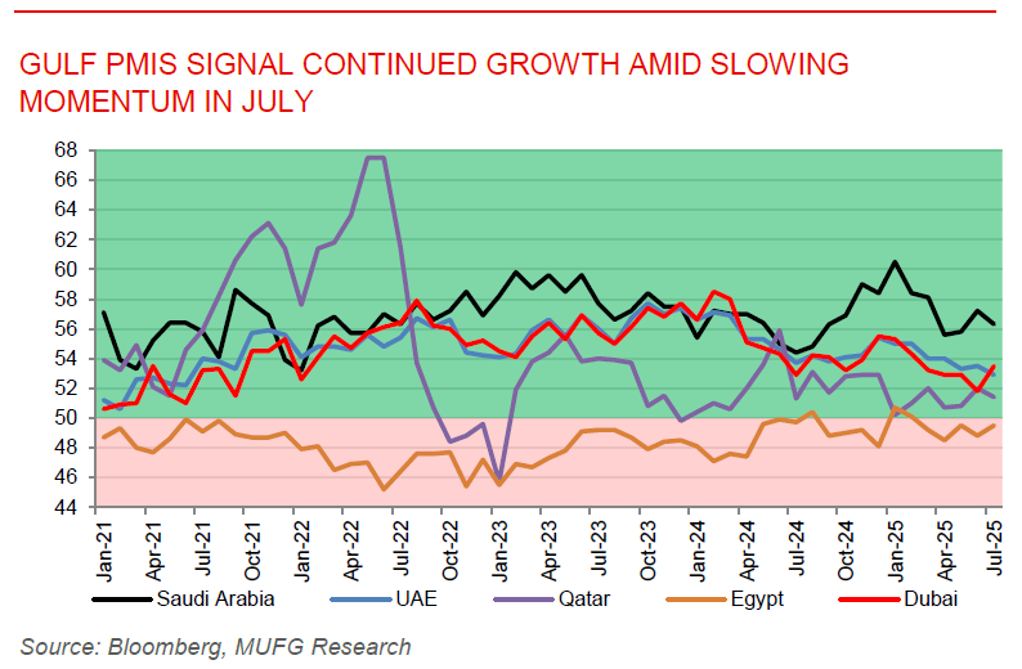To read the full report, please download the PDF above.
Middle East Daily
SOOJIN KIM
Research Analyst
DIFC Branch – Dubai
T: +44(4)387 5031
E: soojin.kim@ae.mufg.jp
MUFG Bank, Ltd. and MUFG Securities plc
A member of MUFG, a global financial group
Middle East Daily
COMMODITIES / ENERGY
Oil slips for fourth day amid demand concerns and OPEC+ output hike. Oil prices extended a four-day decline, with Brent hovering near USD68/b and WTI near USD65/b, as investors largely brushed off President Trump’s threat of secondary sanctions on buyers of Russian oil and focused instead on signs of weakening US economic conditions and rising supply. Despite Trump’s looming August 8 deadline for Russia to reach a truce with Ukraine, the market has so far treated his rhetoric as noise. US data pointed to a stagnating services sector and a weaker labour market, raising concerns about slowing energy demand. Meanwhile, OPEC+ agreed to raised output by 547,000b/d starting in September, fuelling fears of oversupply. Inventory data showed mixed signals, with nationwide crude stocks down but Cushing and distillate inventories up. Market structure also softened, as Brent’s prompt spread narrowed, suggesting waning bullish momentum.
Gold extended rally on US slowdown fears and rate cut bets. Gold maintained its longest winning streak since February, supported by growing concerns over a US economic slowdown and expectations of interest rate cuts, which boosted demand for safe-haven assets. Gold hovered near USD3,383/oz, following a more than 3% gain over the past four sessions. Recent US data pointed to stagnation in the services sector and ongoing weakness in the labour market and consumer spending, adding to signs of tariff-related economic strain. These indicators have strengthened market expectations of a Fed rate cut in September. Although gold has surged nearly 30% this year amid trade tensions, geopolitical uncertainty, and waning confidence in the dollar, it has remained range-bound in recent months.
MIDDLE EAST - CREDIT TRADING
End of day comment – 05 August 2025. The market continues to trade like it cares about spreads with buyers of most names across sectors as we are still +10bps in Index and +9bps in EM IG from last week, albeit from eye watering tight levels. This move wider has definitely not triggered any kind of re-evaluation of positions with the exception of some light two way interest in HY corps the market is still bid for risk. The street opened up bid in KSA names this morning with KSA and ARAMCO giving back the initial 3-4bps spread move tighter through the day, but PIFKSA and the pipelines remaining bid through the UST movements of the day. For the first time in a while the long end outperformed the short end with ARAMCO in particular well bid in 54s and 55s. Across the rest of corps and fins bonds were mostly unchanged in spread terms. For Turkey Corps & Fins, there has been some two way action in these corp names, but the general trend is higher in cash. ZOREN is all the way back to 11.5% after teasing the high teens and there is demand for QNBFB bonds tight to Turkey sovereign. 5yr senior bank paper is also in demand.
MIDDLE EAST - MACRO / MARKETS
Gulf PMIs signal continued growth amid slowing momentum. In July 2025, PMI readings across key gulf economies pointed to continued non-oil private sector growth, though underlying drivers revealed a mix of resilience and softening demand. In the UAE, the headline PMI dropped to 52.9 from 53.5 in June, the slowest expansion since 2021. This decline was largely due to weakening new order growth and subdued business confidence, influenced in part by regional geopolitical uncertainty. However, Dubai bucked the broader trend with a sharp rebound in its PMI to 53.5 from 51.8, driven by a notable recovery in sales volumes and improved domestic demand. In Qatar, the PMI slipped to 51.4 from 52.0 as the pace of new business growth slowed and firms adopted a more cautious hiring approach despite ongoing expansion. Meanwhile, Saudi Arabia continued to lead the region, though its PMI eased to 56.3 from a three-month high of 57.2. The slight decline reflected slower output growth and a drop in export orders, even as domestic demand remained strong and employment continued to rise at a robust pace. Overall, while all PMIs remained above the 50-point threshold, the regional cooling reflects a moderation in demand and output following strong performance earlier in the year.
EU proposed additional EUR500million in Macro-Financial Assistance to Jordan. The European Commission proposed a new EUR500 million Macro-Financial Assistance (MFA) package to Jordan, aiming to support fiscal consolidation and structural reforms in key areas like public finance, governance, and the business environment. This follows a similar EUR500 million package approved in April, bringing total EU MFA to Jordan to EUR1bn for 2025-2027. The assistance will be conditional on progress under Jordan’s IMF programme and continued adherence to democratic principles and human rights. Since 2011, the EU has mobilised around EUR4bn in support of Jordan, helping the country navigate challenges from regional conflicts, while fostering inclusive growth, investment, and long-term resilience. The proposal now awaits approval from the European Parliament and Council.

